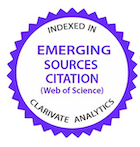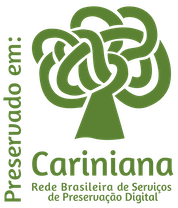Hormese induzida por glifosato em cultivares de Urochloa com aplicação sequencial
DOI:
https://doi.org/10.1590/1809-6891v24e-75471EResumo
Após a aplicação do herbicida glifosato para controle de plantas daninhas em cultivo agrícola, constata-se que a deriva do produto pode estimular crescimento e/ou rendimento produtivo em plantas não-alvo, localizadas nas adjacências do tratamento, caracterizando efeito hormese. Entretanto, os efeitos horméticos por glifosato podem ser diferentes para uma determinada espécie vegetal, o que depende da dose e do estágio de desenvolvimento da planta. Pressupondo estímulo de produção de biomassa de forragem para alimentação animal, o trabalho teve por objetivo avaliar o efeito hormese por aplicações sucessivas de subdose de glifosato em cultivares do gênero Urochloa. Foram avaliadas as respostas produtivas aérea e radicular em três cultivares de gramíneas (Urochloa brizantha cv. Marandu, U. brizantha cv. Piatã e U. ruziziensis cv. Ruziziensis) por aplicação foliar das subdoses do equivalente ácido (e.a.) de glifosato (5,40; 10,80; 21,60; 43,20; e, 86,40 g e.a. ha-1) e controle. Foram avaliadas quatro colheitas sequenciais, realizadas com frequência de 21 dias, em esquema fatorial 6 x 3 x 4, com três repetições, em delineamento inteiramente casualizado. Dose igual e superior a 43,2 g e.a. ha-1 de glifosato, em duas aplicações sequenciais, prejudicaram a produção de biomassa das forrageiras avaliadas. Dentre os cultivares, Ruziziensis foi mais susceptível ao efeito fitotóxico. Aplicações sequenciais das subdoses 5,40 e 10,80 g e.a. ha-1 de glifosato, caracterizaram efeito hormético, promovendo a produção de biomassa aérea e radicular das forrageiras Marandu, Piatã e Ruziziensis.
Palavras-chave: deriva; equivalente ácido; forragem; hormese; Urochloa
Downloads
Referências
Associação Brasileira de Defensivos Pós-Patente. Saiba quais são os princípios ativos dos agrotóxicos mais vendidos no mundo. Available from: https://www.aenda.org.br/noticia_imprensa/saiba-quais-sao-os-principios-ativos-dos-agrotoxicos-mais-vendidos-no-mundo/
Amarante Junior OP, Santos TCR, Brito NM, Ribeiro ML. Glifosato: propriedades, toxicidade, usos e legislação. Química Nova. 2002; 25(4):589–93. Available from: https://doi.org/10.1590/S0100-40422002000400014
Yamada T, Castro PRC. Efeito do glifosato nas plantas: implicações fisiológicas e agronômicas. Peachtree Corners: IPNI – International Plant Nutrition Institute, 2007; 32p. (Informações Agronômicas, n. 119). Available from: https://www.ipni.net/publication/ia-brasil.html
Calabrese EJ, Baldwin LA. Applications of hormesis in toxicology, risk assessment and chemotherapeutics. Trends Pharmacol Science. 2002; 23(7):323-331. Available from: https://doi.org/10.1016/S0165-6147(02)02034-5
Carvalho, LBD, Alves, PLCA, Duke, SO. Hormesis with glyphosate depends on coffee growth stage. Anais da Academia Brasileira de Ciências, 2013, 85(2): 813–822. Available from: https://doi.org/10.1590/S0001-37652013005000027
Felisberto P, Timossi P, Felisberto G, Ramos, A. Subdoses de glyphosate não reduzem a produtividade da cultura do milho. Revista Brasileira de Herbicidas. 2016; 15(3), 290-296. Available from: https://doi.org/10.7824/rbh.v15i3.482
Codognoto LC, Conde TT, Maltoni KL, Faria, GA. Glyphosate in the production and forage quality of marandu grass. Semina Ciências Agrárias. 2021; 42(3, supl. 1), 1695-1706. Available from: https://doi.org/10.5433/1679-0359.2021v42n3Supl1p1695
Meschede D, Carbonari C, Velini E, Trindade M, Gomes G. Efeitos do glyphosate nos teores de lignina, celulose e fibra em Brachiaria decumbens. Revista Brasileira de Herbicidas. 2011; 10(1), 57-63. Available from: https://doi.org/10.7824/rbh.v10i1.77
Codognoto LC, Conde TT, Maltoni KL, Faria GA, Cavali J. Effects of glyphosate plus foliar manganese application on the production and quality of marandu grass. Acta Scientiarum. Animal Sciences. 2021; 43, e52796. Available from: https://doi.org/10.4025/actascianimsci.v43i1.52796
Vital RG, Jakelaitis A, Silva FB, Batista PF, Almeida GM, Costa A C, Rodrigues AA. Physiological changes and in the carbohydrate content of sunflower plants submitted to sub-doses of glyphosate and trinexapac-ethyl. Bragantia. 2017; 76(1), 33–44. Available from: https://doi.org/10.1590/1678-4499.540
Gitti DC, Arf O, Peron IBG, Portugal JR, Corsini DCDC, Rodrigues RAF. Glyphosate como regulador de crescimento em arroz de terras altas. Pesquisa Agropecuária Tropical. 2011; 41(4), 500–507. Available from: https://doi.org/10.5216/pat.v41i4.10160
Meschede D, Velini E, Carbonari C. Baixas doses de glyphosate e seus efeitos no crescimento de Commelina benghalensis. Revista Brasileira de Herbicidas. 2008; 7(2), 53-58. Available from: https://doi.org/10.7824/rbh.v7i2.61
Lima SF, Pereira LS, Sousa GD, Vasconcelo SA, Jakelaitis A, Oliveira JFA. Influence of glyphosate underdoses on the suppression of Panicum maximum cultivars. Arquivos do Instituto Biológico. 2018; 85:e0812017. Available from: https://doi.org/10.1590/1808-1657000812017
Santos N, Azenha M, Souza FH, Reis R, Ruggieri AC. Fatores ambientais e de manejo na qualidade de pastos tropicais. Enciclopédia Biosfera, 2011; 7(13). Available from: https://conhecer.org.br/ojs/index.php/biosfera/article/view/4143
Silveira RR, Santos MV, Ferreira EA, Braz TGS, Santos JB, Andrade JCA, Costa JPR, Silva AMS, Silva L. Controle e susceptibilidade de capim-braquiária e capim-ruziziensis ao glyphosate e fluazifop-p-butil. Archivos de Zootecnia. 2019; 68(263):403-410. Available from: https://doi.org/10.21071/az.v68i263.4199
Dias-Filho MB. Formação e manejo de pastagens. Belém: Embrapa Amazônia Oriental; 2012. 9p. (Embrapa Amazônia Oriental. Comunicado técnico, 235). Available from: https://www.embrapa.br/busca-de-publicacoes/-/publicacao/937485/formacao-e-manejo-de-pastagens
Bortoluzzi FM, Cabral CEA, Machado RAF, Abreu JG, Cabral CHA, Barros LV. Fosfato natural reativo aplicado em épocas distintas e associado a fertilizantes nitrogenados afetam a produção de capim-marandu. Boletim de Indústria Animal. 2017; 74(1):9-16. Available from: https://doi.org/10.17523/bia.v74n1p9
Cantarutti RB, Martins CE, Fonseca DM, Vilela H, Oliveira FTT. Pastagens. In: Ribeiro AC, Guimarães P T G, Alvarez VVH (ed.). Recomendação para o uso de corretivos e fertilizantes em Minas Gerais. 5a aproximação. Viçosa, MG, CFSEMG; 1999. p. 332-341.
Detmann E, Costa e Silva LF, Rocha GC, Palma MNN, Rodrigues JPP. Métodos para análise de alimentos - INCT - Ciência Animal. Visconde do Rio Branco: Suprema; 2021. 350p.
Ferreira DF. SISVAR: a computer analysis system to fixed effects split plot type designs. Revista Brasileira de Biometria. 2019; 37(4):529-535. Available from: https://doi.org/10.28951/rbb.v37i4.450
Nweke CO, Ogbonna C. Statistical models for biphasic dose-response relationships (hormesis) in toxicological studies. Ecotoxicology and Environmental Contamination. 2017; 12(1):39-55. Available from: https://doi.org/10.5132/eec.2017.01.06
Moraes CP, Tropaldi L, Brito IPFS, Carbonari CA, Velini ED. Determinação da dose de controle de Brachiaria decumbens pela aplicação de glyphosate. Revista Brasileira de Herbicidas. 2019; 18(1):e618. Available from: https://doi.org/10.7824/rbh.v18i1.618
Carbonari CA, Gomes GLGC, Velini ED, Machado RF, Simões OS, Macedo GC. Glyphosate effects on sugarcane metabolism and growth. American Journal of Plant Sciences. 2014; 5:3585-3593. Available from: http://dx.doi.org/10.4236/ajps.2014.524374
Vidal RA, Pagnoncelli FD, Fipke MV, Queiroz AR, Bittencourt HV, Trezzi MM. Fatores ambientais que afetam a eficácia de glifosato: Síntese do conhecimento. Pesticidas: Revista de Ecotoxicologia e Meio Ambiente. 2014; 24:43-52. Available from: http://dx.doi.org/10.5380/pes.v24i1.39028
Nascentes RF, Fagan EB, Soares LH, Oliveira CB, Brunelli MC. Hormesis de Glyphosate em Brachiaria brizanta cv. Marandu. Cerrado Agrociências. 2015; 6:55-64. Available from: https://revistas.unipam.edu.br/index.php/cerradoagrociencias/issue/view/76/Edi%C3%A7%C3%A3o%20completa2015
Nascentes RF, Carbonari CA, Simões PS, Brunelli MC, Velini ED, Duke SO. Low doses of glyphosate enhance growth, CO2 assimilation, stomatal conductance and transpiration in sugarcane and eucalyptus. Pest Management Science. 2017; 74(5):1197-1205. Available from: https://doi.org/10.1002/ps.4606
Rodrigues RC, Mourão GB, Valinote AC, Herling VR. Reservas orgânicas, relação parte aérea-raiz e C-N e eliminação do meristema apical no capim-xaraés sob doses de nitrogênio e potássio. Ciência Animal Brasileira. 2007; 8:505-514. Available from: https://revistas.ufg.br/vet/article/view/1714
Silva JC, Gerlach GAX, Rodrigues RAF, Arf O. Influência de doses reduzidas e épocas de aplicação sobre o efeito hormético de glyphosate em feijoeiro. Revista de la Facultad de Agronomía. 2016; 115(2):191-199. Available from: http://sedici.unlp.edu.ar/handle/10915/58020
Pincelli‐Souza RP, Bortolheiro FPAP, Carbonari CA, Velini ED, Silva MA. Hormetic effect of glyphosate persists during the entire growth period and increases sugarcane yield. Pest Management Science. 2020; 76(7):2388-2394. Available from: https://doi.org/10.1002/ps.5775
Cedergreen, N. Is the growth stimulation by low doses of glyphosate sustained over time? Environmental Pollution. 2008; 156(3):1099-1104. Available from: https://doi.org/10.1016/j.envpol.2008.04.016
Lima SF, Pereira LS, Sousa GD, Oliveira GS, Jakelaitis A. Supressão de Brachiaria brizantha e U. ruziziensis por subdodoes do glicosato. Revista Caatinga. 2019; 32(3):581-589. Available from: https://doi.org/10.1590/1983-21252019v32n302rc
Curran, S. Decline of adaptive homeostasis & hormesis in aging, Innovation in Aging. 2018; 2(1):428-429. Available from: https://doi.org/10.1093/geroni/igy023.1605
Mielke KC, Silva, MGB, Paula DF, Mendes, KF. Induced Hormesis in Plants with Herbicide Underdoses. In: Mendes KF, Silva, AA (Org.). Applied Weed and Herbicide Science. 1ed.Berlin, Germany: Springer. 2022; 1:210-232. Available from: https://doi.org/10.1007/978-3-031-01938-8_6
Brighenti AM, Sobrinho FS, Rocha WSD, Martins CE, Demartini D, Costa TR. Suscetibilidade diferencial de espécies de braquiária ao herbicida glifosato. Pesquisa Agropecuária Brasileira. 2011; 46(10):1241-1246. Available from: https://doi.org/10.1590/S0100-204X2011001000018
Costa NV, Peres EJL, Ritter L, Silva PV. Doses de glyphosate na dessecação de Urochloa ruziziensis antecedendo o plantio do milho. Scientia Agraria Paranaensis. 2014; 13(2):117–125. Available from: https://doi.org/10.18188/sap.v13i2.6722
Matias ML, Gonçalves VO, Braz GBP, Andrade CLL, Silva AG da, Barroso AL de L. Uso de subdoses de glyphosate na supressão de espécies forrageiras consorciadas com milho. Científica. 2019; 47(4):380-387. Available from: http://dx.doi.org/10.15361/1984-5529.2019v47n4p380-387
Codognoto LC, Conde TT, Faria GA, Maltoni KL. Doses subletais de glifosato em combinação com manganês foliar na produção de capim marandu. Archivos de Zootecnia. 2020; 69(267):294-299. Available from: https://doi.org/10.21071/az.v69i267.5348
Campos AAV, Ronchi CP. Interação entre tamanhos de vaso e doses de glifosato no controle de braquiária. Planta Daninha. 2015; 33(4):727-738. Available from: https://doi.org/10.1590/S0100-83582015000400011
Brito IP, Tropaldi L, Carbonari CA, Velini ED. Hormetic effects of glyphosate on plants. Pesticide Management Science. 2017; 74:1064-1070. Available from: https://doi.org/10.1002/ps.452
Downloads
Publicado
Como Citar
Edição
Seção
Licença
Copyright (c) 2023 Ciência Animal Brasileira / Brazilian Animal Science

Este trabalho está licenciado sob uma licença Creative Commons Attribution 4.0 International License.
Autores que publicam nesta revista concordam com os seguintes termos:
- Autores mantém os direitos autorais e concedem à revista o direito de primeira publicação, com o trabalho simultaneamente licenciado sob a Licença Creative Commons Attribution que permite o compartilhamento do trabalho com reconhecimento da autoria e publicação inicial nesta revista.
- Autores têm autorização para assumir contratos adicionais separadamente, para distribuição não-exclusiva da versão do trabalho publicada nesta revista (ex.: publicar em repositório institucional ou como capítulo de livro), com reconhecimento de autoria e publicação inicial nesta revista.
- Autores têm permissão e são estimulados a publicar e distribuir seu trabalho online (ex.: em repositórios institucionais ou na sua página pessoal) a qualquer ponto antes ou durante o processo editorial, já que isso pode gerar alterações produtivas, bem como aumentar o impacto e a citação do trabalho publicado (Veja O Efeito do Acesso Livre).






























